lesson plan (MS Word 38 KB)
advertisement
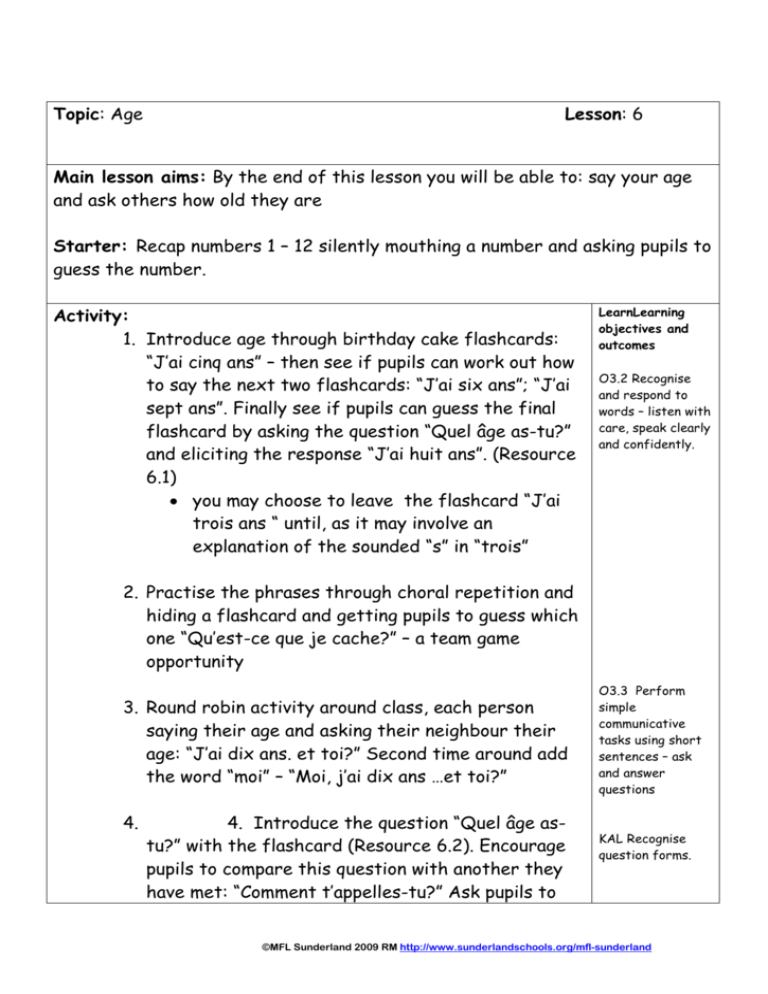
Topic: Age Lesson: 6 Main lesson aims: By the end of this lesson you will be able to: say your age and ask others how old they are Starter: Recap numbers 1 – 12 silently mouthing a number and asking pupils to guess the number. Activity: 1. Introduce age through birthday cake flashcards: “J’ai cinq ans” – then see if pupils can work out how to say the next two flashcards: “J’ai six ans”; “J’ai sept ans”. Finally see if pupils can guess the final flashcard by asking the question “Quel âge as-tu?” and eliciting the response “J’ai huit ans”. (Resource 6.1) you may choose to leave the flashcard “J’ai trois ans “ until, as it may involve an explanation of the sounded “s” in “trois” LearnLearning objectives and outcomes O3.2 Recognise and respond to words – listen with care, speak clearly and confidently. 2. Practise the phrases through choral repetition and hiding a flashcard and getting pupils to guess which one “Qu’est-ce que je cache?” – a team game opportunity 3. Round robin activity around class, each person saying their age and asking their neighbour their age: “J’ai dix ans. et toi?” Second time around add the word “moi” – “Moi, j’ai dix ans …et toi?” 4. 4. Introduce the question “Quel âge astu?” with the flashcard (Resource 6.2). Encourage pupils to compare this question with another they have met: “Comment t’appelles-tu?” Ask pupils to O3.3 Perform simple communicative tasks using short sentences – ask and answer questions KAL Recognise question forms. ©MFL Sunderland 2009 RM http://www.sunderlandschools.org/mfl-sunderland identify the question word in both – “Quel” and “Comment” – repeat each question drawing a question mark in the air when they say each question. Encourage pupils to find other similarities:- both verbs end in “s” (which is silent); both have “tu” at the end. 5.Do the round robin activity again, this time pupils ask the full question:- “(moi),j’ai dix ans .. quel âge as-tu?” 6.Cocktail activity (Resource 6.3). Each pupil is given a card with the name and age of a person. They have to find the people who have the same card as themselves and thereby get themselves into age groups. They do this by asking “Quel âge as-tu?” LLS Practice new language with a friend. Look at the face of the person speaking and listen attentivelying objectives: Plenary:. Teacher throws a ball to someone in the class and asks them the question “Quel âge as-tu?” – They answer and throw to someone else. This could be extended to other questions met so far: “Comment t’appelles-tu?”; “Comment ça s’écrit?”; “Comment ça va?” Resources required: Res 6.1 – flashcards Res 6.2 – question phrase Res 6.3-cocktail activity Res 6.4- board game Res 6.5 written flash cards Language Required: Numbers from lesson 5 J’ai…ans I am …old Moi – me Et toi – and you Quel âge as-tu ? How old are you ? Follow on activities: 1. Using the cards from Cocktail activity (Resource 6.3), teacher gives each pupil a card and plays some music. Pupils wander around the classroom and when the music stops they have to ask the person/people next to them a question relating to the card. The teacher will have said what the question is before they started wandering. Possible questions are: “Comment t’appelles-tu?”; “Comment ça s’écrit?”; “Quel âge as-tu?”; ©MFL Sunderland 2009 RM http://www.sunderlandschools.org/mfl-sunderland 2. 3. 4. 5. “Comment ça va?” Board game (Resource 6.4). Pupils play in groups of 4. The aim is to be the first to get to the end of the board, but if they land on a picture square they must say their age – there are some danger squares and some lucky squares as well! Look at how question formation can be changed and the position of the question word – compare “Comment t’appelles-tu?” and “Tu t’appelles comment?” (Lesson 2) to “Quel âge as-tu?” and “Tu as quel âge?” Hold a number flashcard above a pupils head – they must try to guess how old they are. Pupils in the class ask “Quel âge as-tu?” – Pupil guesses “J’ai trois ans” etc. Use finger puppets to create extended conversations ©MFL Sunderland 2009 RM http://www.sunderlandschools.org/mfl-sunderland
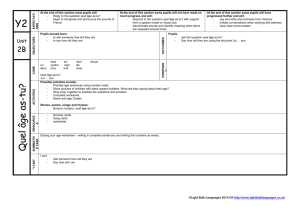
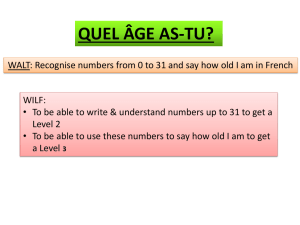
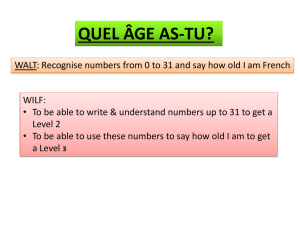

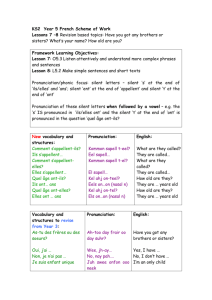

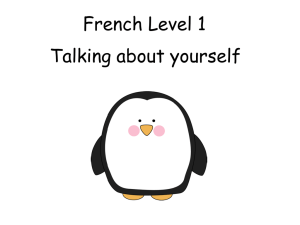

![afl_mat[1]](http://s2.studylib.net/store/data/005387843_1-8371eaaba182de7da429cb4369cd28fc-300x300.png)
